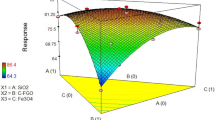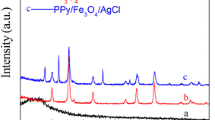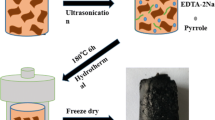Abstract
A facile hydrothermal route is investigated to prepare a new sorbent based on rGO@CNT@Fe2O3. The synthesis is easy and does not involve complex chemistry. The as prepared sorbent are characterized by scanning electron microscopy (SEM), X-ray diffraction, Raman spectroscopy, and Fourier transform infrared spectroscopy (FTIR). Chromium ions adsorption capacity of sorbent reaches 91.7 mg/g at contact time of 240 min at 298 K, and the data is fitted to Freundlich adsorption isotherm model, with second-order kinetics. Further analysis of the mechanism proved that the binding of Cr (VI) to sorbent was mainly a synergistic effect of electrostatic attraction, and ion exchange reduction. Overall, these results shed new light on the search for new composites and revealed the potential practical application of rGO@CNT@Fe2O3 in the removal of heavy metals in solution.
Graphical Abstract






Similar content being viewed by others
References
Sun Y, Yu F, Li L, Ma J (2021) Adsorption–reduction synergistic effect for rapid removal of Cr (VI) ions on superelastic NH2–graphene sponge. Chem Eng J 421:129933. https://doi.org/10.1016/j.cej.2021.129933
Liu Y, Ding J, Lu X, You H (2018) Study on the DNA-protein crosslinks induced by chromium (VI) in SPC-A1. IOP Conf Ser Earth Environ Sci 108:042096. https://doi.org/10.1088/17551315/108/4/042096
Campillo-Cora C, Rodríguez-González L, Arias-Estévez M, Fernández-Calviño D, Soto-Gómez D (2021) Influence of physicochemical properties and parent material on chromium fractionation in soils. Processes 9:1073. https://doi.org/10.3390/pr9061073
Saha R, Nandi R, Saha B (2011) Review: sources and toxicity of hexavalent chromium. J Coord Chem 64:1782. https://doi.org/10.1080/00958972.2011.583646
Saha B, Orvig C (2010) Biosorbents for hexavalent chromium elimination from industrial and municipal effluents. Coord Chem Rev 254:2959–2972. https://doi.org/10.1016/j.ccr.2010.06.005
Liu W, Li J, Zheng J, Song Y, Shi Z, Lin Z, Chai L (2020) Different pathways for Cr (III) oxidation: implications for Cr (VI) reoccurrence in reduced chromite ore processing residue. Environ Sci Technol 54:11971–11979. https://doi.org/10.1021/acs.est.0c01855
Ahmadi A, Foroutan R, Esmaeili H, Tamjidi S (2020) The role of bentonite clay and bentonite clay@MnFe2O4 composite and their physico-chemical properties on the removal of Cr (III) and Cr (VI) from aqueous media. Environ Sci Pollut Res 27:14044–14057. https://doi.org/10.1007/s11356-020-07756-x
Saha R, Saha I, Nandi R, Ghosh A, Basu A, Ghosh SK, Saha B (2013) Application of Chattim tree (devil tree, Alstonia scholaris) saw dust as a biosorbent for removal of hexavalent chromium from contaminated water. Can J Chem Eng 91:814–821. https://doi.org/10.1002/cjce.21703
Mondal MH, Begum W, Nasrollahzadeh M, Ghorbannezhad F, Antoniadis V, Levizou E, Saha B (2021) A comprehensive review on chromium chemistry along with detection, speciation, extraction and remediation of hexavalent chromium in contemporary science and technology. Vietnam J Chem 59:711–732. https://doi.org/10.1002/vjch.202100048
Rahman Z, Singh VP (2019) The relative impact of toxic heavy metals (THMs) (arsenic (As), cadmium (Cd), chromium (Cr)(VI), mercury (Hg), and lead (Pb)) on the total environment: an overview. Environ Monit Assess 191:419. https://doi.org/10.1007/s10661-019-7528-7
Karimi-Maleh H, Ayati A, Ghanbari S, Orooji Y, Tanhaei B, Karimi F, Alizadeh M, Rouhi J, Fu L, Sillanpää M (2021) Recent advances in removal techniques of Cr (VI) toxic ion from aqueous solution: a comprehensive review. J Mol Liq 329:115062. https://doi.org/10.1016/j.molliq.2020.115062
Singh P, Chowdhuri DK (2017) Environmental presence of hexavalent but not trivalent chromium causes neurotoxicity in exposed Drosophila melanogaster. Mol Neurobiol 54:3368–3387. https://doi.org/10.1007/s12035-016-9909-z
Pakade VE, Tavengwa NT, Madikizela LM (2019) Recent advances in hexavalent chromium removal from aqueous solutions by adsorptive methods. RSC Adv 9:26142–26164. https://doi.org/10.1007/s12035-016-9909-z
Sivaranjanee R, Saravanan A (2018) Carbon sphere: synthesis, characterization and elimination of toxic Cr (VI) ions from aquatic system. J Ind Eng Chem 60:307–320. https://doi.org/10.1016/j.jiec.2017.11.017
Vaiopoulou E, Gikas P (2020) Regulations for chromium emissions to the aquatic environment in Europe and elsewhere. Chemosphere 254:126876. https://doi.org/10.1016/j.chemosphere.2020.126876
Wang Y, Huang L, Wang Z, Wang L, Han Y, Liu X, Ma T (2019) Application of polypyrrole flexible electrode for electrokinetic remediation of Cr (VI)-contaminated soil in a main-auxiliary electrode system. Chem Eng J 373:131–139. https://doi.org/10.1016/j.cej.2019.05.016
Peng H, Guo J (2020) Removal of chromium from wastewater by membrane filtration, chemical precipitation, ion exchange, adsorption electrocoagulation, electrochemical reduction, electrodialysis, electrodeionization, photocatalysis and nanotechnology: a review. Environ Chem Lett 18:2055–2068. https://doi.org/10.1007/s10311-020-01058-x
Li LL, Feng XQ, Han RP, Zang SQ, Yang G (2017) Cr (VI) removal via anion exchange on a silver-triazolate MOF. J Hazard Mater 321:622–628. https://doi.org/10.1016/j.jhazmat.2016.09.029
Riaz T, Ahmad A, Saleemi S, Adrees M, Jamshed F, Hai AM, Jamil T (2016) Synthesis and characterization of polyurethane–cellulose acetate blend membrane for chromium (VI) removal. Carbohydr Polym 153:582–591. https://doi.org/10.1016/j.carbpol.2016.08.011
Chen G, Feng J, Wang W, Yin Y, Liu H (2017) Photocatalytic removal of hexavalent chromium by newly designed and highly reductive TiO2 nanocrystals. Water Res 108:383–390. https://doi.org/10.1016/j.watres.2016.11.013
Sattari-Najafabadi M, Esfahany MN (2020) Hexavalent chromium extraction from aqueous solutions in a liquid–liquid slug flow microreactor. Chem Eng Process: Process Intensif 157:108156. https://doi.org/10.1016/j.cep.2020.108156
Sall ML, Diaw AKD, Gningue-Sall D, Chevillot-Biraud A, Oturan N, Oturan MA, Aaron JJ (2017) Removal of Cr (VI) from aqueous solution using electrosynthesized 4-amino-3-hydroxynaphthalene-1-sulfonic acid doped polypyrrole as adsorbent. Environ Sci Pollut Res 24:21111–21127. https://doi.org/10.1007/s11356-017-9713-y
Mondal MH, Malik S, Garain A, Mandal S, Saha B (2017) Extraction of natural surfactant saponin from soapnut (Sapindus mukorossi) and its utilisation in the remediation of hexavalent chromium from contaminated water. Tenside Surfactants Deterg 54:519–529. https://doi.org/10.3139/113.110523
Nandi R, Laskar S, Saha B (2017) Surfactant-promoted enhancement in bioremediation of hexavalent chromium to trivalent chromium by naturally occurring wall algae. Res Chem Intermed 43:1619–1634. https://doi.org/10.1007/s11164-016-2719-0
Mukherjee K, Nandi R, Saha D, Saha B (2015) Surfactant-assisted bioremediation of hexavalent chromium from contaminated water. Desalin Water Treat 53:746–751. https://doi.org/10.1080/19443994.2013.842503
Mukherjee K, Nandi R, Saha D, Saha B (2015) Surfactant-assisted enhancement of bioremediation rate for hexavalent chromium by water extract of Sajina (Moringa oleifera) flower. Desalin Water Treat 54:525–532. https://doi.org/10.1080/19443994.2014.884477
Saravanan A, Kumar PS, Govarthanan M, George CS, Vaishnavi S, Moulishwaran B, Kumar SP, Jeevanantham S, Yaashikaa PR (2021) Adsorption characteristics of magnetic nanoparticles coated mixed fungal biomass for toxic Cr (VI) ions in aquatic environment. Chemosphere 267:129226. https://doi.org/10.1016/j.chemosphere.2020.129226
Kumar PS, Sivaranjanee R, Rajan PS, Saravanan A (2018) Carbon sphere: synthesis, characterization and elimination of toxic Cr (VI) ions from aquatic system. J Ind Eng Chem 60:307–320. https://doi.org/10.1016/j.jiec.2017.11.017
Bao S, Yang W, Wang Y, Yu Y, Sun Y (2021) Highly efficient and ultrafast removal of Cr (VI) in aqueous solution to ppb level by poly(allylamine hydrochloride) covalently cross-linked amino-modified graphene oxide. J Hazard Mater 409:124470. https://doi.org/10.1016/j.jhazmat.2020.124470
Mpouras T, Polydera A, Dermatas D, Verdone N, Vilardi G (2021) Multi wall carbon nanotubes application for treatment of Cr (VI)-contaminated groundwater; modeling of batch and column experiments. Chemosphere 269:128749. https://doi.org/10.1016/j.chemosphere.2020.128749
Al-Wafi R, Ahmed MK, Mansour SF (2020) Tuning the synthetic conditions of graphene oxide/magnetite/hydroxyapatite/cellulose acetate nanofibrous membranes for removing Cr (VI), Se (IV) and methylene blue from aqueous solutions. J Water Process Eng 38:101543. https://doi.org/10.1016/j.jwpe.2020.101543
Chatterjee S, Mahanty S, Das P, Chaudhuri P, Das S (2020) Biofabrication of iron oxide nanoparticles using manglicolous fungus Aspergillus niger BSC-1 and removal of Cr (VI) from aqueous solution. Chem Eng J 385:123790. https://doi.org/10.1016/j.cej.2019.123790
Zhang R, Tian Y (2020) Characteristics of natural biopolymers and their derivative as sorbents for chromium adsorption: a review. J Leather Sci Eng 2:24. https://doi.org/10.1186/s42825-020-00038-9
Pfeifer A, Škerget M (2020) A review: a comparison of different adsorbents for removal of Cr (VI), Cd (II) and Ni (II). Turk J Chem 44:859–883. https://doi.org/10.3906/kim-2002-21
Yu F, Bai XT, Liang MX, Ma J (2021) Recent progress on metal–organic framework derived porous carbon and its composite for pollutant adsorption from liquid phase. Chem Eng J 405:126960. https://doi.org/10.1016/j.cej.2020.126960
Chen GD, Xu YY, Huang L, Douka AI, Xia BY (2021) Continuous nitrogen-doped carbon nanotube matrix for boosting oxygen electrocatalysis in rechargeable Zn–air batteries. J Energy Chem 55:183–189. https://doi.org/10.1016/j.jechem.2020.07.012
Ma J, Xiong YC, Dai XH, Yu F (2020) Coadsorption behavior and mechanism of ciprofloxacin and Cu (II) on graphene hydrogel wetted surface. Chem Eng J 380:122387. https://doi.org/10.1016/j.cej.2019.122387
Reis ES, Gorza FDS, Pedro GC, Maciel BG, da Silva RJ, Ratkovski GP, de Melo CP (2021) (Maghemite/chitosan/polypyrrole) nanocomposites for the efficient removal of Cr (VI) from aqueous media. J Environ Chem Eng 9:104893. https://doi.org/10.1016/j.jece.2020.104893
Huang Y, Lee X, Macazo FC, Grattieri M, Cai R, Minteer SD (2018) Fast and efficient removal of chromium (VI) anionic species by a reusable chitosan-modified multi-walled carbon nanotube composite. Chem Eng J 339:259–267. https://doi.org/10.1016/j.cej.2018.01.133
Karthikeyan P, Elanchezhiyan SSD, Banu HAT, Farzana MH, Park CM (2021) Hydrothermal synthesis of hydroxyapatite-reduced graphene oxide (1D–2D) hybrids with enhanced selective adsorption properties for methyl orange and hexavalent chromium from aqueous solutions. Chemosphere 276:130200. https://doi.org/10.1016/j.chemosphere.2021.130200
Mondal NK, Chakraborty S (2020) Adsorption of Cr (VI) from aqueous solution on graphene oxide (GO) prepared from graphite: equilibrium, kinetic and thermodynamic studies. Appl Water Sci 10:61. https://doi.org/10.1007/s13201-020-1142-2
Ihsanullah A-K, Abu-Sharkh B, Abulkibash AM, Qureshi MI, Laoui T, Atieh MA (2016) Effect of acid modification on adsorption of hexavalent chromium (Cr (VI)) from aqueous solution by activated carbon and carbon nanotubes. Desalin Water Treat 57:7232–7244. https://doi.org/10.1080/19443994.2015.1021847
Fall B, Diaw AKD, Fall M, Sall ML, Lo M, Gningue-Sall D, Thotiyl MO, Maria HJ, Kalarikkal N, Thomas S (2021) Synthesis of highly sensitive rGO@CNT@Fe2O3/polypyrrole nanocomposite for the electrochemical detection of Pb2+. Mater Today Commun 26:102005. https://doi.org/10.1016/j.mtcomm.2020.102005
Frantz TS, Silveira N, Quadro MS, Barcelos AA, Cadaval TRS Jr, Pinto LAA (2017) Cu(II) adsorption from copper mine water by chitosan films and the matrix effects. Environ Sci Pollut Res 24:5908–5917. https://doi.org/10.1007/s11356-016-8344-z
Thue PS, Adebayo MA, Lima EC, Sieliechi JM, Machado FM, Dotto GL, Vaghetti JCP, Dias SLP (2016) Preparation, characterization and application of microwave-assisted activated carbons from wood chips for removal of phenol from aqueous solution. J Mol Liq 223:1067–1080. https://doi.org/10.1016/j.molliq.2016.09.032
Ba S, Alagui A, Hajjaji M (2018) Retention and release of hexavalent and trivalent chromium by chitosan, olive stone activated carbon, and their blend. Environ Sci Pollut Res 25:19585–19604. https://doi.org/10.1007/s11356-018-2196-7
Xiang L, Niu C-G, Tang N, Lv X-X, Guo H, Li Z-W, Liang C (2021) Polypyrrole coated molybdenum disulfide composites as adsorbent for enhanced removal of Cr (VI) in aqueous solutions by adsorption combined with reduction. Chem Eng J 408:127281. https://doi.org/10.1016/j.cej.2020.127281
Patra C, Shahnaz T, Subbiah S, Narayanasamy S (2020) Comparative assessment of raw and acid-activated preparations of novel Pongamia pinnata shells for adsorption of hexavalent chromium from simulated wastewater. Environ Sci Pollut Res 27:14836–14851. https://doi.org/10.1007/s11356-020-07979-y
Shi S, Yang J, Liang S, Li M, Gan Q, Xiao K, Hu J (2018) Enhanced Cr (VI) removal from acidic solutions using biochar modified by Fe3O4@SiO2–NH2 particles. Sci Total Environ 628:499–508. https://doi.org/10.1016/j.scitotenv.2018.02.091
Kumar A, Jena HM (2017) Adsorption of Cr (VI) from aqueous phase by high surface area activated carbon prepared by chemical activation with ZnCl2. Process Saf Environ Prot 109:63–71. https://doi.org/10.1016/j.psep.2017.03.032
Al-Homaidan AA, Al-Qahtani HS, Al-Ghanayem AA, Ameen F, Ibraheem IBM (2018) Potential use of green algae as a biosorbent for hexavalent chromium removal from aqueous solutions. Saudi J Biol Sci 25:1733–1738. https://doi.org/10.1016/j.sjbs.2018.07.011
Kaur J, Kaur M, Ubhi MK, Kaur N, Greneche J-M (2021) Composition optimization of activated carbon–iron oxide nanocomposite for effective removal of Cr (VI) ions. Mater Chem Phys 258:124002. https://doi.org/10.1016/j.matchemphys.2020.12
Taha A, Da’na E, Hassanin HA, (2021) Modified activated carbon loaded with bio-synthesized Ag/ZnO nanocomposite and its application for the removal of Cr (VI) ions from aqueous solution. Surf Interfaces 23:100928. https://doi.org/10.1016/j.surfin.2021.100928
Guo N, Lv X, Li Q, Ren T, Song H, Yang Q (2020) Removal of hexavalent chromium from aqueous solution by mesoporous α-FeOOH nanoparticles: performance and mechanism. Micropor Mesopor Mat 299:110101. https://doi.org/10.1016/j.micromeso.2020.110101
Pholosi A, Naidoo EB, Ofomaja AE (2020) Intraparticle diffusion of Cr (VI) through biomass and magnetite coated biomass: a comparative kinetic and diffusion study. S Afr J Chem Eng 32:39–55
Fang W, Jiang X, Luo H, Geng J (2018) Synthesis of graphene/SiO2@polypyrrole nanocomposites and their application for Cr (VI) removal in aqueous solution. Chemosphere 197:594–602. https://doi.org/10.1016/j.chemosphere.2017.12
Xu Y, Chen J, Chen R, Yu P, Guo S, Wang X (2019) Adsorption and reduction of chromium(VI) from aqueous solution using polypyrrole/calcium rectorite composite adsorbent. Water Res 160:148–157. https://doi.org/10.1016/j.watres.2019.05.055
Deng S, Wang P, Zhang G, Dou Y (2016) Polyacrylonitrile-based fiber modified with thiosemicarbazide by microwave irradiation and its adsorption behavior for Cd(II) and Pb(II). J Hazard Mater 307:64–72. https://doi.org/10.1016/j.jhazmat.2016.01.002
Liang H, Song B, Peng P, Jiao G, Yan X, She D (2019) Preparation of three-dimensional honeycomb carbon materials and their adsorption of Cr (VI). Chem Eng J 367:9–16. https://doi.org/10.1016/j.cej.2019.02.121
Araújo CST, Almeida ILS, Rezende HC, Marcionilio SMLO, Léon JJL, de Matos TN (2018) Elucidation of mechanism involved in adsorption of Pb(II) onto lobeira fruit (Solanum lycocarpum) using Langmuir, Freundlich and Temkin isotherms. Microchem J 137:348–354. https://doi.org/10.1016/j.microc.2017.11.009
Sridevi M, Nirmala C, Jawahar N, Arthi G, Vallinayagam S, Sharma VK (2021) Role of nanomaterial’s as adsorbent for heterogeneous reaction in waste water treatment. J Mol Struct 1241:130596. https://doi.org/10.1016/j.molstruc.2021.130596
Vinhal JO, Nege KK, Lage MR, de Carneiro JW, M, Lima CF, Cassella RJ, (2017) Adsorption of the herbicides diquat and difenzoquat on polyurethane foam: kinetic, equilibrium and computational studies. Ecotoxicol Environ Saf 145:597–604. https://doi.org/10.1016/j.ecoenv.2017.08.005
Unuabonah EI, Adebowale KO, Olu-Owolabi BI (2007) Kinetic and thermodynamic studies of the adsorption of lead (II) ions onto phosphate-modified kaolinite clay. J Hazard Mater 144:386–395. https://doi.org/10.1016/j.jhazmat.2006.10.046
Sari A, Mendil D, Tuzen M, Soylak M (2009) Biosorption of palladium (II) from aqueous solution by moss (Racomitrium lanuginosum) biomass: equilibrium, kinetic and thermodynamic studies. J Hazard Mater 162:874–879. https://doi.org/10.1016/j.jhazmat.2008.05.112
Foroutan R, Peighambardoust SJ, Ahmadi A, Akbari A, Farjadfard S, Ramavandi B (2021) Adsorption mercury, cobalt, and nickel with a reclaimable and magnetic composite of hydroxyapatite/Fe3O4/polydopamine. J Environ Chem Eng 9:105709. https://doi.org/10.1016/j.jece.2021.105709
Khan MA, Kim SW, Rao RAK, Abou-Shanab RAI, Bhatnagar A, Song H, Jeon BH (2010) Adsorption studies of dichloromethane on some commercially available GACs: effect of kinetics, thermodynamics and competitive ions. J Hazard Mater 178:963–972. https://doi.org/10.1016/j.jhazmat.2010.02.032
Abdulkareem H, Alwared A (2019) Immobilization dried mix of algae for copper removal. Iraqi J Agric Sci 50:800–808
Karimi-Maleh H, Orooji Y, Ayati A, Qanbari S, Tanhaei B, Karimi F, Alizadeh M, Rouhi J, Fu L, Sillanpää M (2020) Recent advances in removal techniques of Cr (VI) toxic ion from aqueous solution: a comprehensive review. J Mol Liq 329:115062. https://doi.org/10.1016/j.molliq.2020.115062
Islam MdA, Angove MJ, Morton DW (2019) Recent innovative research on chromium (VI) adsorption mechanism. Environ Nanotechnol Monit Manag 12:100267. https://doi.org/10.1016/j.enmm.2019.100267
Wang K, Chen P, Nie W, Xu Y, Zhou Y (2019) Improved photocatalytic reduction of Cr (VI) by molybdenum disulfide modified with conjugated polyvinyl alcohol. Chem Eng J 359:1205–1214. https://doi.org/10.1016/j.cej.2018.11.057
Xiang L, Niu C-G, Tang N, Lv X-X, Guo H, Li Z-W, Liu H-Y, Lin L-S, Yang Y-Y, Liang C (2021) Polypyrrole coated molybdenum disulfide composites as adsorbent for enhanced removal of Cr (VI) in aqueous solutions by adsorption combined with reduction. Chem Eng J 408:127281. https://doi.org/10.1016/j.cej.2020.127281
Acknowledgements
The authors gratefully acknowledge the Ministry of Higher Education, Research and Innovation, Senegal, for his mobility grant allocated to BF during this work and the support of Indian Institute of Science Education and Research (IISER), Pune (India) and of Mahatma Gandhi University, Kottayam, Kerala (India). The authors are grateful to the International Science Program (ISP), University of Uppsala (Sweden) for its financial support through the African Network of Electroanalytical Chemists (ANEC) and to TWAS, the World Academy of Science for the Advancement of Science in developing countries for financial and material support (TWAS RGA no. 16-499RG/CHE/AF/AC_G–FR3240293299).
Author information
Authors and Affiliations
Corresponding author
Ethics declarations
Conflict of interest
The authors declare no conflict of interest. Modou Fall is Associate Editor of Chemistry Africa.
Rights and permissions
Springer Nature or its licensor holds exclusive rights to this article under a publishing agreement with the author(s) or other rightsholder(s); author self-archiving of the accepted manuscript version of this article is solely governed by the terms of such publishing agreement and applicable law.
About this article
Cite this article
Fall, B., Gaye, C., Niang, M. et al. Removal of Toxic Chromium Ions in Aqueous Medium Using a New Sorbent Based on rGO@CNT@Fe2O3. Chemistry Africa 5, 1809–1821 (2022). https://doi.org/10.1007/s42250-022-00499-x
Received:
Accepted:
Published:
Issue Date:
DOI: https://doi.org/10.1007/s42250-022-00499-x




